
Cyrtostylis, commonly known as gnat orchids, is a genus of five or six species of flowering plants in the orchid family Orchidaceae and is native to Australia and New Zealand. Cyrtostylis orchids often form dense colonies of genetically identical plants. They have a single heart-shaped leaf and a thin flowering stem with pale coloured insect-like flowers. The lateral sepals and petals are similar in size and colour but the labellum is shelf-like and conspicuous with two prominent glands at its base.

Pterostylis grandiflora, commonly known as the cobra greenhood or superb greenhood, is a species of orchid endemic to south-eastern Australia. As with similar orchids, the flowering plants differ from those which are not flowering. The non-flowering plants have a rosette of leaves but the flowering plants lack a rosette and have a single flower with leaves on the flowering spike. This greenhood has a green and white, striped flower with deep red-brown markings especially on its "galea", and a sharply pointed dorsal sepal.

Rimacola elliptica, commonly known as the green rock orchid or green beaks, is the only species of plant in the orchid genus Rimacola and is endemic to New South Wales. It is an evergreen species which grows in clumps in sandstone cracks and has bright green leaves and in late spring, produces arching flower stems with up to eighteen dull greenish flowers with reddish or brown markings. It only grows near Sydney, mainly in the Blue Mountains and near Fitzroy Falls.

Dendrobium aemulum, commonly known as the ironbark feather orchid or white feather orchid, is an epiphytic orchid in the family Orchidaceae and grows on trees that retain their bark, especially ironbarks. It has reddish or purplish pseudobulbs, two to four leathery leaves and up to seven white, feathery flowers. It grows in open forest in Queensland and New South Wales.

Pterostylis obtusa, commonly known as the blunt-tongue greenhood, is a species of orchid endemic to New South Wales. It is distinguished from similar greenhood orchids by its thick, flat, platform-like sinus and blunt labellum which is only just visible above the sinus.

Pterostylis cucullata, commonly known as the leafy greenhood, is a plant in the orchid family Orchidaceae and is endemic to south-eastern Australia. It has a rosette of fleshy leaves at its base and a single white, green and reddish-brown flower.
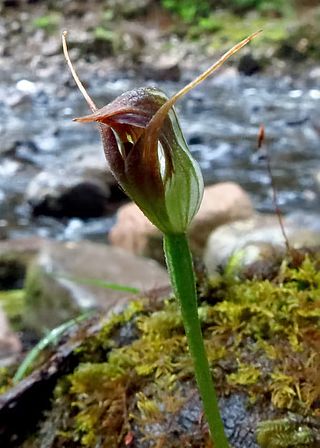
Pterostylis pedunculata, commonly known as the upright maroonhood, is a species of orchid endemic to south-eastern Australia. Flowering plants have a rosette of two to six stalked leaves and a single green flower which is white near its base and tinged with reddish brown to black and with a gap between the petals and lateral sepals. It is common and widespread in a range of habitats.

Pterostylis revoluta, commonly known as the autumn greenhood, is a species of orchid endemic to south-eastern Australia. As with similar greenhoods, the flowering plants differ from those which are not flowering. The non-flowering plants have a rosette of leaves flat on the ground but the flowering plants have a single flower with leaves on the flowering spike. This greenhood has white and green flowers that have a long, curved, pointed labellum which extends beyond the sinus between the lateral sepals.

Pterostylis squamata, commonly known as the southern rustyhood or ruddyhood, is a plant in the orchid family Orchidaceae and is endemic to south-eastern Australia. Flowering plants have up to ten translucent green flowers with reddish-brown markings and a hairy, insect-like labellum. Non-flowering plants have a rosette of four to eight egg-shaped leaves. This species is very similar to Pterostylis rufa which has a narrower labellum and other minor differences.
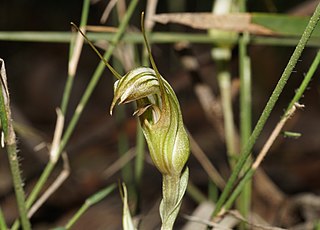
Pterostylis ophioglossa, commonly known as the snake-tongue greenhood, is a species of orchid endemic to eastern Australia. It has a rosette of leaves at the base and a single dull green, white and brown flower with a deeply notched labellum.
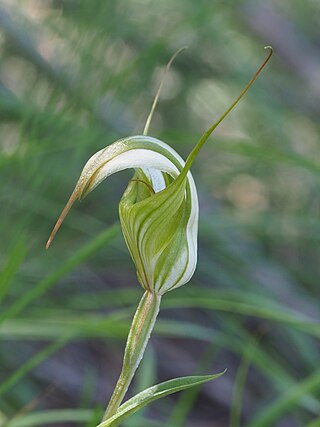
Pterostylis reflexa, commonly known as the dainty greenhood, is a species of orchid endemic to New South Wales. As with similar greenhoods, the flowering plants differ from those which are not flowering. The non-flowering plants have a rosette of leaves flat on the ground but the flowering plants have a single flower with leaves on the flowering stem. This greenhood has a relatively large white, green and light brown flower with a long, curved dorsal sepal and a protruding labellum.

Pterostylis rufa, commonly known as the red rustyhood is a plant in the orchid family Orchidaceae and is endemic to south-eastern Australia. It has a rosette of leaves and up to fifteen bright reddish-brown flowers with translucent white "windows" and a dark brown, insect-like labellum. It occurs from southern Queensland to south-eastern South Australia.
Prasophyllum australe, commonly known as southern leek orchid or austral leek orchid, is a species of orchid and is endemic to south-eastern Australia. It has a single tubular, green leaf and up to fifty scented, greenish-brown flowers with red stripes.

Acianthus caudatus, commonly known as mayfly orchid, is a species of flowering plant in the orchid family Orchidaceae and is endemic to eastern Australia. It is a terrestrial herb with a single egg-shaped or heart-shaped leaf and up to nine dark purplish flowers with thin, spreading sepals and petals, often with a musty odour.

Prasophyllum striatum, commonly known as the streaked leek orchid, is a species of orchid endemic to New South Wales. It has a single thin, tube-shaped leaf and up to ten greenish and whitish flowers with reddish or purplish stripes. It differs from other leek orchids in having a very thin leaf and prominently streaked flowers.

Chiloglottis diphylla, commonly known as the common wasp orchid, is a species of orchid endemic to Australia. It has two broad leaves and a single narrow, greenish brown to reddish flower with a black, insect-like callus covering the upper surface of the labellum.

Cyrtostylis robusta, commonly known as large gnat-orchid or mosquito orchid, is a species of orchid endemic to southern Australia. It usually has a single more or less round leaf and a flowering spike with up to seven reddish flowers with a shelf-like labellum.
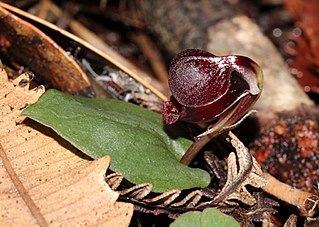
Corybas unguiculatus, commonly known as the small helmet orchid or pelicans, is a species of terrestrial orchid endemic to south-eastern Australia. It is a widespread, sometimes common but small orchid with a single leaf and a single reddish purple to reddish black flower.
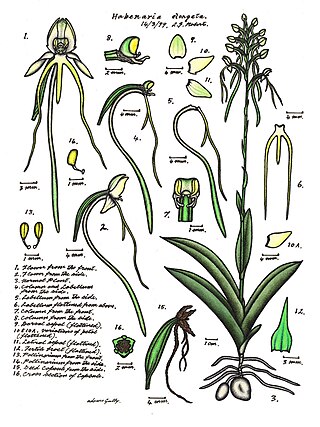
Habenaria elongata, commonly known as the white rein orchid, or Kimberley spider orchid, is a species of orchid that is endemic to northern Australia. It has up to four leaves at its base and up to twenty small white flowers with yellowish tips and thread-like lobes on the labellum.

Habenaria ochroleuca, commonly known as the sickle orchid or sickle habenaria, is a species of orchid that is endemic to northern Australia. It has two or three broad, glabrous leaves and up to twenty five white flowers on a flowering stem with many overlapping bracts. The side lobes of the labellum curve upwards.



















